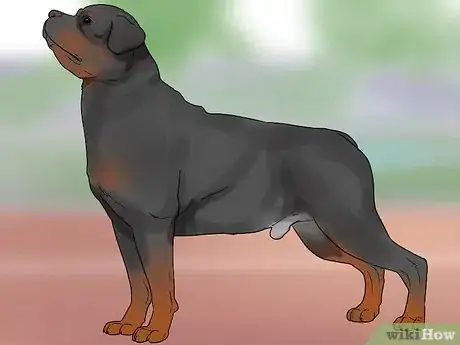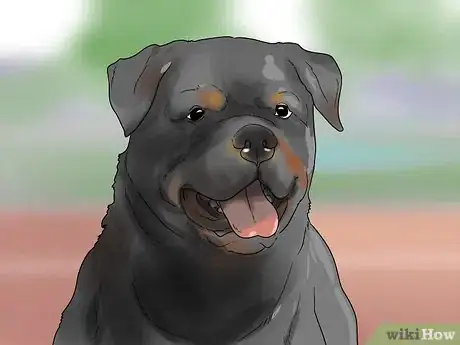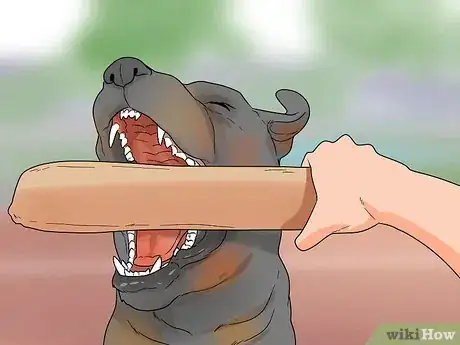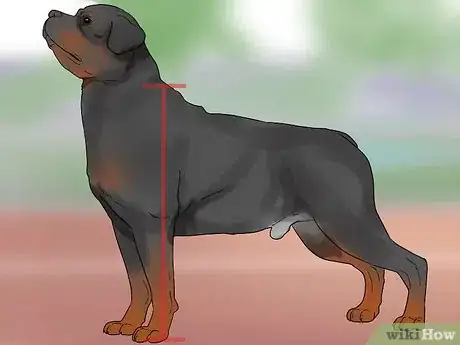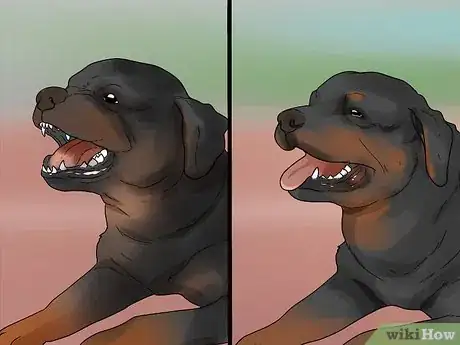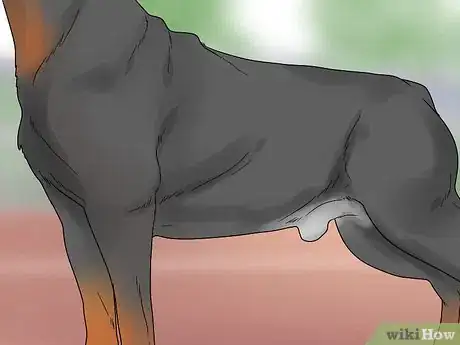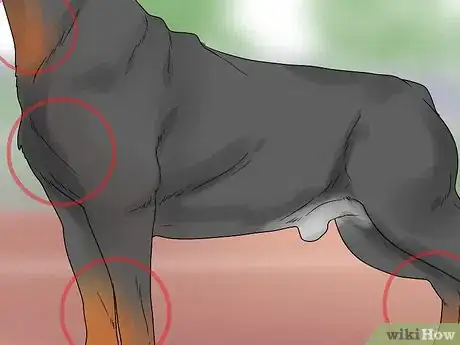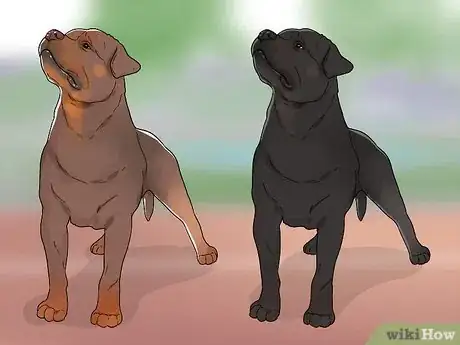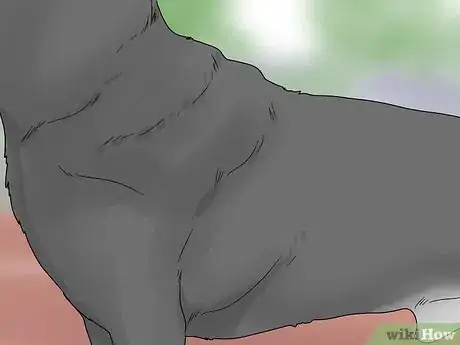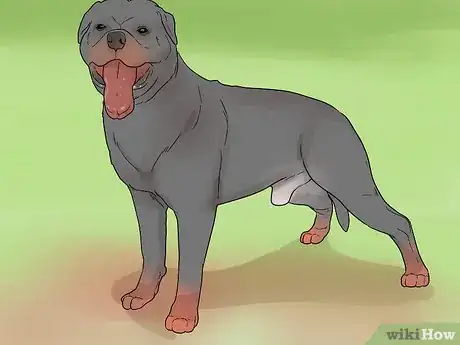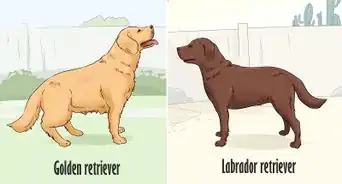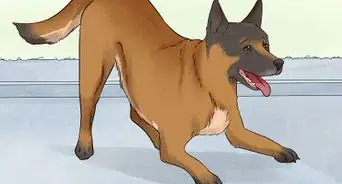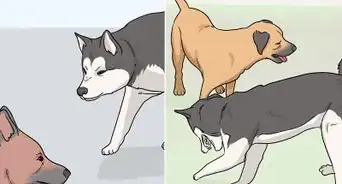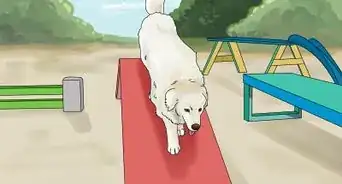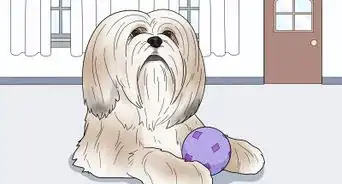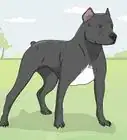This article was co-authored by David Schmucker. David Schmucker is a Dog Trainer and a Senior Trainer at Sidewalk Dog Training in Washington D.C. With over 17 years of experience, David specializes in canine training programs such as dog aggression training, dog behavioral correction, and dog separation anxiety training. David holds a BS in Personnel & Labor Management from the University of Maryland.
There are 9 references cited in this article, which can be found at the bottom of the page.
wikiHow marks an article as reader-approved once it receives enough positive feedback. This article received 11 testimonials and 100% of readers who voted found it helpful, earning it our reader-approved status.
This article has been viewed 249,679 times.
Rottweilers are a very distinct breed of dog originating in Germany. Called "Rottie" for short, they are known for their protective nature. The breed is a common sight in America, and learning to identify a Rottweiler or Rottweiler cross can prove to be a rewarding experience. To the untrained eye, several breeds of dogs can look the same. But with proper training, one can distinguish a purebred Rottweiler from other dogs.
Steps
Assessing Physical and Personality Traits
-
1Look at the conformation. Conformation means the physical appearance of the dog. Rottweilers have an overall stocky look, with a wide chest, long back, and thick legs. Typically they range from 2 to 2 1⁄2 feet (0.6 to 0.8 m) tall at the shoulder, though it is not uncommon for them to be even taller. Rottweilers are powerful, muscular dogs, and the overall shape of the animal should invoke a feeling of strength and agility.
- They have large, heavy paws with high knuckles, and are never flat-footed.
- Their legs are straight, not bowed outwards, and typically stand such that their shoulders are even with or slightly higher than their hindquarters.
- Their necks are thick, nearly the same diameter around as their heads.
- The tail is usually docked (cut short), but not always, so the presence of a long tail cannot automatically disqualify a Rottweiler from being a purebred Rottweiler.
-
2Look at the head. Their heads are very boxy, being about the same height as width, and only slightly longer from nose to the back of the head. Rottweilers can have a slight wrinkling effect around the eyes, but this should not be too pronounced.[1]
- The ears of a Rottweiler will always fold down with a triangular shape, similar to but smaller than a Labrador Retrievers, and they will never stand upright like a German Shepherd Dog or hang like a Basset Hound.
Advertisement -
3Notice their jaw strength. It is also important to note that, of the recognized breeds, Rottweilers are typically credited as having the second strongest bite pressure, behind only the pit bull, when measured in pounds per square inch. To this end, the jaws are robust and heavy, and the head wide in order to accommodate the large muscles needed to achieve this kind of strength.
- Rottweilers will never have underbites like English Bulldogs.
-
4Recognize deviations among individuals. Not every Rottweiler is a perfect specimen. Some may be stockier, longer, taller, leaner, or otherwise different than others of the same breed. Remember that while breed types are usually pretty all-inclusive, it is possible to have small variations, especially those that are environmental in nature, within the same breed.[2]
- It is also important to consider that, like people, some Rottweilers are overweight, and will resemble more of a barrel shape than a tapered athlete. This does not mean the dog is not a Rottweiler, just that it has been spoiled with food.
-
5Notice common personality traits. Rottweilers were initially bred for work as protectors and guardians. This means they can be quite dominant, and even aggressive on occasion. Rottweilers are intelligent and active dogs who enjoy playing and completing tasks. As long as you give them a comfortable and loving environment, Rottweilers won't be aggressive.[3]
- Rottweilers can be very gentle and loving dogs, but they require a lot of training and guidance from an early age.
- Without proper training as a puppy, Rottweilers can become destructive pets who bark constantly and chew up your furniture or dig in the yard.
Watching for the Right Color Markings
-
1Look at the coloring. All Rottweilers have a black base coat on their bodies with distinctive tan markings on their chests, legs, and face. The tan can be a range of colors from a dark mahogany to a red or rusty color, but the black will always be black, never grey or merle, (a mix of colors.) The brown is typically isolated to the dog's paws, the insides of its legs, its chest, its throat and muzzle, and two distinct dots above the eyes.[4]
- This pattern is so unique to the breed that it is simply called "Rottweiler color," even when found on mixed breed dogs.
- The only other breed to have this coloration naturally is the Doberman Pinscher, which also originated in Germany, but the Doberman Pinscher is very lean, long, and tall, as it was bred for running more than for fighting and intimidation.
- The Australian Kelpie has very similar markings, but as with the Doberman Pinscher, it is more elongated with its features and more athletic in its activity and prowess.
-
2Notice the variations in the markings. The actual size and shape of the markings may vary between individual dogs. For example, some dogs may have an upside-down wishbone-shaped brown mark on their chests, while others may have a butterfly shape, two separate dots on each pectoral (chest muscle), or just a shapeless smudge. The important thing to remember is the overall positioning of the markings.[5]
- Some dogs may also have white markings on them. This is considered a fault by the breed standards, but nonetheless some purebred Rottweilers may have white on the chest, between the shoulders, or on the face or paws.
- Sometimes older dogs will develop white in these areas as well. In these cases, the white is not a fault, but simply an effect of aging. The white on older Rottweilers will typically look more grizzled than pure white, however.
-
3Acknowledge rare colorations. Rarely, Rottweilers can be born albino, all red, or with a "bluish" color. These are considered breed faults, but are not predictable. Albino Rottweilers are all white with pink skin and red eyes, but otherwise conform to the breed's physical characteristics. Keep in mind that these are rare mutations, and a red or blue Rottweiler is most likely a mix.[6]
- A red Rottweiler conforms to all the breed's physical standards, but is all brown or red instead of having the typical black and red coloration.
- A Rottweiler is said to be "blue" when the guard hairs of the coat are a lighter color than the undercoat, resulting in an overall bleaching effect that washes out the entire color.
Recognizing Mixed Breeds
-
1Look for the Rottweiler traits. Just because a dog has the Rottweiler color and a stocky build does not make it a Rottweiler. Other breeds, such as the English Mastiff, American Mastiff, Bullmastiff, or Pit Bull can resemble a Rottweiler, and can produce offspring that may look similar to a purebred Rottweiler. Mixed breeds typically have either the conformation of a Rottweiler or the Rottweiler color, but rarely both.
- A mastiff mix with a Rottweiler will often have jowls or cheeks that hang below its chin when the mouth is closed, and will have excess skin and wrinkling around the face and head.
-
2Notice the dog’s coat. Mixed breeds will often have a longer coat than the short hair of a purebred Rottweiler. Other mixes will produce longer hair than a purebred; one of the most common mixes is Rottweiler with German Shepherd, which sometimes results in a dog with the color and size of a Rottweiler, but the furriness and tail of a German Shepherd.[7]
- A lean dog with a long, thin muzzle and Rottweiler coloring may be mixed with a Labrador Retriever or Doberman Pinscher.
-
3Look at the stance. Because of their athleticism and bite strength, Rottweilers are often crossed with Pit Bulls for the purposes of dog fighting. These crosses are typically smaller than purebred Rottweilers, and have a wider, almost bulldog-like stance.
- Also, a Rottweiler with a curly tail will always be a mix of some kind.[8]
-
4Rule out mixed breeds with proper documentation. In order to be certain that you have a purebred Rottweiler and not, in fact, a mixed breed dog, you should try to acquire some breed registration paperwork. Most purebred dogs have paperwork that accompanies them when they are given to their owners from the breeder.
- The paperwork will most likely come from the American Kennel Club (AKC) or the United Kennel Club (UKC), the two largest registration organizations in the United States for purebred dogs.
-
5Have a DNA test done. There are a variety of companies that sell home DNA test kits for dogs. Buy one of these kits and follow the directions to take a sample of your dog's DNA. Then, you can mail it back to the company, where they'll determine exactly what kind of breed or mixed breed your dog is.[9]
Expert Q&A
-
QuestionHow can you tell if a Rottweiler puppy is purebred?
 David SchmuckerDavid Schmucker is a Dog Trainer and a Senior Trainer at Sidewalk Dog Training in Washington D.C. With over 17 years of experience, David specializes in canine training programs such as dog aggression training, dog behavioral correction, and dog separation anxiety training. David holds a BS in Personnel & Labor Management from the University of Maryland.
David SchmuckerDavid Schmucker is a Dog Trainer and a Senior Trainer at Sidewalk Dog Training in Washington D.C. With over 17 years of experience, David specializes in canine training programs such as dog aggression training, dog behavioral correction, and dog separation anxiety training. David holds a BS in Personnel & Labor Management from the University of Maryland.
Dog Trainer The easiest way is to look at the puppy's mother and father—if you get a pup, the parents are typically available to you. If you adopted the puppy from a rescue group, Google pictures of Rottweiler puppies and compare those pics to your pup to see if you notice any appropriate characteristics.
The easiest way is to look at the puppy's mother and father—if you get a pup, the parents are typically available to you. If you adopted the puppy from a rescue group, Google pictures of Rottweiler puppies and compare those pics to your pup to see if you notice any appropriate characteristics.
Warnings
- Rare red Rottweilers are often mixed with other breeds. If a breeder is attempting to sell you a red Rottie for a premium price, be very, very skeptical. Ask to see the parent dogs and the parent dogs' AKC or UKC certifications.⧼thumbs_response⧽
- Understand that Rottweilers may be banned in certain areas due to their stigma as a "dangerous" breed.[10] Make sure to check the breed bans in your area.⧼thumbs_response⧽
References
- ↑ http://www.akc.org/dog-breeds/rottweiler/
- ↑ http://www.dogbreedinfo.com/rottweiler.htm
- ↑ http://www.hillspet.com/en/us/dog-breeds/rottweiler
- ↑ http://www.akc.org/dog-breeds/rottweiler/
- ↑ https://www.apps.akc.org/apps/registration/colormarkings.cfm
- ↑ http://www.a-love-of-rottweilers.com/red-rottweiler.html
- ↑ http://www.yourpurebredpuppy.com/buying/articles/mixed-breed-dogs.html
- ↑ http://www.4rottweilers.com/rottweiler_natural_tail.htm
- ↑ https://www.wisdompanel.co.uk/
About This Article
You can learn to identify a Rottweiler by looking out for a few distinct physical traits. Look for a black base coat with tan markings on the dog’s chest, face, and legs. Also, check that the dog has a boxy shaped head that’s approximately the same width as the height. Check the height of the dog if possible, as Rottweiler’s are 2 - 2 ½ feet tall. Overall, a Rottweiler will look powerful and muscular, and will usually have a docked tail. For more information about how to identify Rottweilers from our veterinarian co-author, such as the personality traits to look for, read on.
